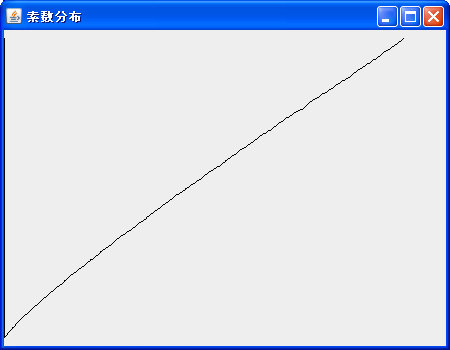
import java.awt.*;
import java.awt.geom.*;
import javax.swing.*;
public class SosuBunpu{
public static void main(String args[]) {
JFrame frame = new JFrame("素数分布");
boolean [] sosu = new boolean [10000];
long[] bunpu = new long[sosu.length];
JLabel lblCanvas = new JLabel();
frame.setDefaultCloseOperation(javax.swing.WindowConstants.EXIT_ON_CLOSE);
frame.add(lblCanvas);
frame.pack();
Dimension screenSize = Toolkit.getDefaultToolkit().getScreenSize();
frame.setBounds((screenSize.width-450)/2, (screenSize.height-350)/2, 450, 350);
for(int i = 2; i < sosu.length; ++i){
sosu[i] = true;
}
for(int i = 2; i < sosu.length; ++i){
if(!sosu[i]) continue;
for(int j = i + i; j < sosu.length; j += i){
sosu[j] = false;
}
}
int n = 0;
for(int i = 0; i < sosu.length; ++i){
if(sosu[i]) ++n;
bunpu[i] = n;
}
Image img = frame.createImage(400, 300);
Graphics2D g = (Graphics2D) img.getGraphics();
Path2D p = new GeneralPath();
p.moveTo(0, 0);
for(int i = 0; i < 400; ++i){
long x = i * bunpu.length / 400;
long y = bunpu[(int)x] * 300 / bunpu[bunpu.length - 1];
p.lineTo(i, 300 - y);
}
g.draw(p);
g.dispose();
ImageIcon ii = new ImageIcon(img);
lblCanvas.setIcon(ii);
frame.setVisible(true);
}
}
